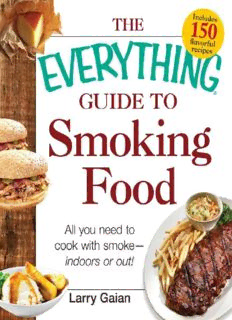
The Everything Guide to Smoking Food: All You Need to Cook with Smoke--Indoors or Out! PDF
Preview The Everything Guide to Smoking Food: All You Need to Cook with Smoke--Indoors or Out!
THE GUIDE TO SMOKING FOOD All you need to cook with smoke— indoors or out! Larry Gaian Avon, Massachusetts This book is dedicated to my wife, Celeste. Her love, support, and inspiration have made everything I do possible. Contents Introduction Introduction to Smoked Foods The History of Smoked Foods Smoking Is Hot Right Now The Temperatures of Smoke Direct Heat versus Indirect Heat The Four Regional Barbecue Styles and Flavors The Science Behind Smoked Foods Why Smoked Foods Taste So Good Why Pit-Smoked Foods Are So Tender Low-and-Slow, Hot-and-Fast, and Grilling Bark, Smoke Rings, and Raw-Looking Chicken Smoking Equipment Essentials Types of Smokers Using a Gas or Charcoal Grill to Smoke Food Plank Smoking Building Your Own Smoker Indoor Smokers Building and Maintaining Fire and Smoke Types of Fuel Wood and Smoke Flavors What Good Smoke Looks and Tastes Like Tips for Smoking Outdoors Tips for Smoking Indoors Brines, Injections, Rubs, and Seasonings Rubs Brines Injections Barbecue Sauces, Mops, and Glazes Barbecue Sauces Mops Glazes Beef and Lamb Pork Seafood Poultry Side Dishes Meatless Menu Items Desserts and Treats Plank Grilling Appendix A: Glossary of Smoking and Cooking Terms Appendix B: Additional Resources Standard U.S./Metric Measurement Conversions Copyright Introduction While this book does contain grilling techniques and tips, this isn’t a book solely about barbecuing and grilling. It’s about one of the oldest cooking processes on earth—smoking. For years now, people all over the world have been using the flavors of smoke to enhance meals. Today smoke is still used as a preservative to a small extent, but for the most part, it’s used to make foods taste better. In fact, smoke can be considered an ingredient in its own right. Herbs, spices, and other ingredients in a recipe meld together in a kind of chemical reaction to make food taste delicious. Smoke is just one more element that adds a layer of flavor. Don’t be intimated, though. Adding smoke flavor to foods doesn’t mean you have to spend eighteen hours watching over a barbecue pit tending the heat, wood, and meat. Adding smoke to something delicate like a scallop so it has a hint of apple wood sweetness is just as rewarding—and far less time-consuming. In this book, you’re going to learn how much fun adding smoke to your foods can be. Smoking foods doesn’t require fancy equipment. You can smoke something with a couple of charcoal briquettes and some wood chips wrapped in foil. There is a good chance most of the tools you need to start smoking a variety of foods are already in your pantry, garage, or patio. You can even use a stovetop smoker to create delicious smoked foods indoors! Whether it’s with a coffee can and a couple of hot briquettes and wood chips or a giant mobile barbecue pit that costs as much as a car, the techniques for creating smoke are not much different. Heat, wood, and just a little oxygen are all you need to make smoke. The recipes found in this book demonstrate a variety of smoking techniques and equipment, from tea smoking using a wok to low-and-slow cooking in a backyard smoker. Remember, these techniques and flavors are easily mixed together. Use these recipes as a guide—mix and match different wood smoke together. Use these recipes as a guide—mix and match different wood smoke flavors, spices, herbs, and other ingredients. Experiment with different combinations of meats, vegetables, marinades, rubs, and sauces. Try different techniques and woods to create your own signature smoke flavor. When it comes to smoking your own foods, there really should be only one rule, and that is: have fun with it! CHAPTER 1 Introduction to Smoked Foods Smoke adds a layer of flavor to foods that, for many people, is the essence of comfort. What was once an essential technique for preserving foods has evolved into a cooking process that is now, for the most part, done to please your taste buds. Smoking is one of the easiest ways to add flavor to foods and can make even the most inexperienced cook look and feel like an expert. The History of Smoked Foods The technique of smoking foods can be traced back to the time when people lived in caves. As hunters hung meat in the cave to dry, they learned that the meat hung closer to a fire would absorb the fire’s smoke. The meat that dried closer to the fire would be better preserved than meat hung farther away—and it tasted different as well. As mankind moved out of caves and into huts or tents, food preservation became more important. A nomadic lifestyle meant meat might not always be readily available, and keeping spoilage to a minimum was vital to survival. Smoking helped solve this problem. For example, the Native Americans of the Pacific Northwest have smoked their annual salmon catch for years by tying the fish to cedar boards and drying them over an open fire. Drying and smoking the salmon gave them the ability to store their fish for the long winters.
Description: